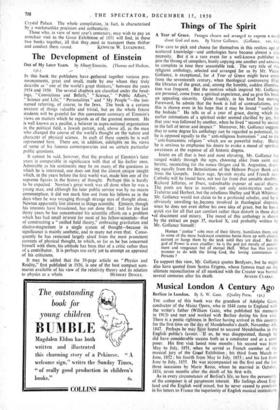The Development of Einstein
IN this book the publishers have gathered together various pro- nouncementS, great and small, made by one whom they truly describe as "one of the world's great thinkers," between the years 1934 and 1950. The several chapters are classified under the head- ings, "Convictions and Beliefs,", "Science," "Public Affairs," "Science and Life," " Personalities " and "My People "—the last- named referring, of course, to the Jews. The book is a curious mixture of things valuable and trivial, but on the whole future students will be grateful for this convenient summary of Einstein's views on matters which he regards as of the greatest moment. He is well known as a pacifist, a believer in supra-national organisation in the political field, a Jewish patriot, and, above all, as the man who changed the course of the world's thought on the 'nature and character of physical science. In each of these aspeCts he is well represented here. There are, in addition, sidelights' on his views of some of his famous contemporaries and on certain particular public questions.
It cannot be said, however, that The product of Einstein's later years is comparable in significance with that of his karlier ones. Admirable as his sentiments may be on many, of the questions in which he is interested, one does not find the almost unique insight which, in the years before the first world war, made him one of the supreme figures in the history of thought. Perhaps this is hardly to be expected. Newton's great work was all done when he was a young man, and although his later public service was by no means commonplace, it did not mark him out from his fellows as in the days when he was voyaging through strange seas of thought alone. Newton apparently lost interest in things scientific. Einstein, though his interests have broadened, has not done that ; but for the last thirty years he has concentrated his scientific efforts on a problem which has had small interest for most of his fellow-Scientists—that of constructing a "unified field theory," embracing gravitation and electro-magnetism in a single system of thought—because its significance is mainly aesthetic, and to many not even that. Conse- quently he has remained largely aloof from the most prominent currents of physical thought, to which, so far as he has concerned himself with them, his attitude has been that of a critic rather than of a contributor. It is perhaps too early yet to attempt an appraisal of his criticisms.
It may be added that the 39-page article on "Physics and Reality," first published in 1936, is one of The best compact sum- maries available of his view of the relativity theory and its relation






































 Previous page
Previous page